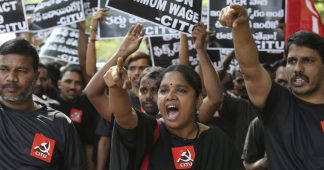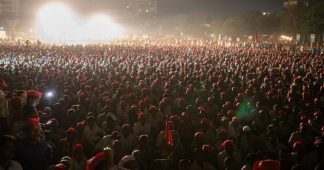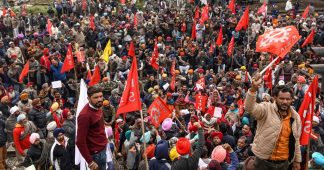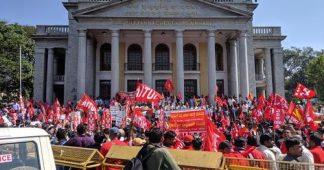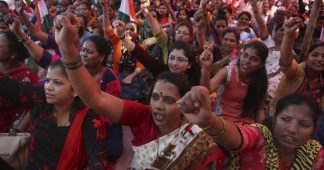Workers in India last week launched a general strike that brought out an estimated 250 million people, arguably the largest in human history. Now, they’re joining hands with farmers to protest Narendra Modi’s pro-corporate, far-right agenda.
By Thomas Crowley
Dec. 1, 2020
photo: General strike in India on November 26
(IndustriALL Global Union / Flickr)
Even more importantly, the general strike converged with a march launched by a broad group of farmers’ organizations, all planning to descend on the capital of Delhi. Social media was suddenly awash with images of farmers using tractors and trucks to break down the barriers erected by police to keep them out of the city. In one video, a protester emphatically explained to a policeman at the barricades that “this is a revolution, sir.”
The government, recognizing the determination of demonstrators, granted them permission to hold a protest in a far-off corner of Delhi, away from the city’s centers of power. Although some farmers ended up at the official protest site, most rejected the offer and remained at the border, with some saying they had brought enough food and provisions to stay for months. This was not merely a symbolic one-day affair. As of Tuesday, the central government has started meeting with farm union leaders, but protesters say that will keep camping at the border until their demands are met.
In many ways, the Delhi march was a continuation of protests that erupted in September, when the BJP-controlled national legislature pushed through three controversial bills meant to open up the agricultural sector to large corporate and financial interests. Farmers fear the legislation is a prelude to the government dismantling the long-standing system of minimum support prices (MSP), which provide some stability to farmers by setting the price at which the government buys a variety of crops.
The government perhaps thought it could slip the bills through amid the COVID chaos (India had just surpassed Brazil in COVID cases that month), but the bills’ passage sparked a widespread outcry, as farmers decried the deepening of neoliberal reforms in the agricultural sector. Protests spread across the country but were strongest in Punjab and Haryana, wealthy northern states that were once ground zero for India’s Green Revolution. Protest leaders generally came from rich peasant backgrounds, though the demonstrations garnered broad, cross-class support from those in the agricultural sector.
Farmers’ movements have always been a fraught topic on the Marxist left, including in India. Going back to Lenin, Kautsky, and Marx himself, leftists have debated the “agrarian question,” at times with the assumption that the peasant is a historical relic, a remnant of feudalism bound to disappear as capitalist relations penetrated the agrarian world. But many decades of capitalist development in India have called into question this assumption, as the peasantry has stubbornly remained a central feature of the country’s economy.
Often divided into categories of rich, middle, and poor peasantry, all of these groups are united in their role as land owners and producers of commodities for the market, though those on the poorer end of the spectrum often combine this work with wage labor, including on other peasants’ farms. As the economists Amit Basole and Deepankar Basu note in a 2011 working paper, “The coexistence of both wage-labour and petty commodity production, whereby landless labourers, marginal farmers and small farmers participate in both, in one as free labor and in the other as owner-producer, has complicated the task of revolutionary politics.”
Such complications came to the fore in the 1980s, as India started to move toward neoliberalism. As the terms of trade shifted away from agriculture, “new farmers’ movements” emerged across the country, largely around demands for higher prices for agricultural commodities. Many Marxists at the time dismissed these as movements comprised of rich peasants who exploited the agrarian proletariat on the ground. Others disagreed, acknowledging stratification within the peasantry but arguing that the vast majority of farmers suffered under neoliberalism.
In their paper, Basole and Basu analyzed five decades of economic and demographic data to determine the precise mechanisms of capitalist exploitation operating in India. In the agricultural sector, they note, “class differentiation is proceeding, albeit in a way different from the European case…. The differentiation that is taking place in rural India is more between a heterogeneous rural gentry and a heterogeneous rural poor, than between capitalist and worker.”
The poorer end of this sector engages in wage labor, and thus is exploited in the classical Marxist sense. But many petty commodity producers, and not just the poorest, face what Basole and Basu call “surplus extraction through unequal exchange.” In this environment, “merchants manage to systematically ensure deviation of prices … from underlying labour values due to their monopoly position in these markets.”
“From the point of view of the working class,” they write, “it is difficult to identify where surplus extraction via unequal exchange stops and that via wage-labor begins.” In addition, small and large farmers alike are trapped in cycles of debt, fueling India’s horrific farmer suicide crisis (a crisis that the pandemic has only exacerbated).
This helps explain why the current farmers’ protests, though led mainly by the rich peasantry, have found widespread support beyond the upper strata of agrarian society. While class and caste divide the broad peasantry, the neoliberal turn has created openings for cross-class and cross-caste alliances in the agrarian sphere. And with the intervention of unions attuned to the needs of the most exploited — agricultural workers, marginal landholders, oppressed castes — farmers’ movements can be pushed to demand more radical change.
The presence of rich farmers in these movements, then, should be seen less as an insurmountable barrier to left organizing than as a challenge to confront with flexibility and attention to the shifting political and economic winds. In recent years, the Left has taken this kind of flexible approach to agrarian organizing; despite its declining electoral fortunes, the Communist Party of India (Marxist), or CPM, played a major role in a massive farmers’ march in 2018, which helped usher in the current round of militant farmer protest.
Even in the electoral realm, the Communist parties are, at least in some places, showing a similar flexibility and political savvy. In the recent elections in the state of Bihar, not just the mainstream Communist parties (the CPM and the Communist Party of India, or CPI), but also the more radical CPI(ML) Liberation — a party with roots in the Maoist-inspired Naxalbari movement, which cut its teeth leading often-violent struggles against extremely regressive systems of landlordship and exploitation — entered into an electoral coalition with other anti-BJP parties.
Flexibility hasn’t always been the Indian left’s forte. In 1996, in an event still referred to as the “historic blunder,” the CPM turned down an offer for the prime ministership of an anti-BJP coalition after national elections produced a hung parliament. So the recent Bihar elections represented a refreshing departure.
Eschewing ideological purity, the three Communist parties joined a coalition led by Tejashwi Yadav of the regional Rashtriya Janata Dal (RJD), a party that has sought to consolidate lower-caste votes in the state with a social justice message. Yadav refused to let the BJP set the terms of the debate along Hindu nationalist lines, instead stressing bread-and-butter issues on which the BJP has not delivered, especially employment. The message resonated with voters in Bihar, as well as with the Communist parties’ campaigns.
In the end, the BJP’s coalition won the election, in part because Yadav’s campaign, though extremely popular, got off the ground too late. Still, the Communist parties, and especially CPI(ML) Liberation, performed exceptionally well, with the latter winning twelve of the nineteen seats it contested.
Some have attributed this showing to the Left’s pragmatism in joining a popular anti-incumbency coalition, but others have pointed to the deep roots and dedicated cadre, especially of CPI(ML) Liberation. As the party emerged from underground and entered electoral politics, it maintained close grassroots connections with the oppressed groups it has long fought alongside.
Among Communist parties, Liberation has been particularly attuned to caste issues, in part because the battles they have waged for agricultural workers have simultaneously been struggles for the dignity of Dalits (those formerly considered “Untouchable”), who make up the bulk of the rural proletariat. As the anti-caste leader Jignesh Mevani has noted, “in the Bihar election, [Liberation] did not field a single upper-caste candidate, changing the popular notion of the Brahminical… Left leadership.”
These glimmers of hope do not mean a left resurgence is inevitable. Despite the massive social, economic, and health devastations of the pandemic, Modi still enjoys broad popularity — in part because unlike his reactionary colleagues Trump and Bolsonaro, Modi has consistently underscored the severity of the epidemic, while framing it as a natural calamity beyond his control. This rhetoric obscures not just the decades of neoliberal disinvestment in public health (which the BJP government has deepened), but also Modi’s own disastrously short-sighted and abrupt lockdown announcement (which put millions of migrant workers out of work, forcing them to make arduous journeys back to their home villages).
But Modi has skillfully deployed the language of shared sacrifice, invoking Hindu mythology and comparing citizens battling COVID to the warriors of the ancient epic the Mahabharata. The Bihar election results suggest he has not been punished for his handling of the pandemic, even though the state is home to many migrant workers whose lives were upended by the sudden lockdown. And at least on the electoral front, no convincing national-level alternatives to the BJP have emerged.
However, as the philosopher Isabelle Stengers once noted, “Hope is the difference between probability and possibility.” The general strike, the farmers’ movement, the Bihar election — all offer the possibility, if not the probability, of pushing back against the dominance of the Right in India, and of navigating the ambiguities of India’s class politics to stitch together a coalition for transformative change.
Published at www.jacobinmag.com
